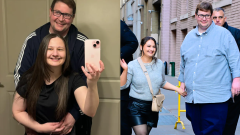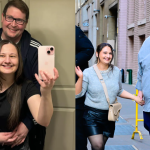
Here at the PEDESTRIAN.TV offices, we’ve been absolutely enamoured by the Winter Olympics. From the constant displays of aerial trickery to the slow-burning tactics of curling, each and every event offers something unique, and no doubt very cold, for us to gawp at.
But nothing seems quite as wild as the sliding sports. Hurling down a frosty chute with a onesie for protection is unfathomable, and yet, each time the Games roll around, fields of competitors risk it all for Olympic glory.
This time around, those competitors included Aussie Alex Ferlazzo, whose 28th place finish at PyeongChang 2018 cemented his spot as our most successful male Olympic luger.
As we watched the 22-year-old go down in history, our incredulity subsided and curiosity took over. We needed to know how he dove into such an insane sport, and how someone from Australia – a nation not known for its bountiful ice – could overcome that challenge to succeed as an elite luger.
So we asked. And Ferlazzo was kind enough to answer.
https://twitter.com/7olympics/status/962654200478892032
Ferlazzo’s luge career didn’t begin on the frost-bitten Alpine slopes, but in a regular Australian pilates class. It was 2010 when his mother randomly met retired luger Karen Flynn at the fitness session, who suggested young Alex try it out. Flynn handled recruitment for Luge Australia, which lead to Ferlazzo’s participation in a talent identification camp for promising youngsters.
Six months after his mum’s post-workout encounter, Ferlazzo was sliding down the Lake Placid luge track in New York State. Four years later, he competed at Sochi, landing 33rd place. Later that year, he secured the gold medal at the Junior World Championship in Canada.
Even though he was just fourteen when he started, Ferlazzo insists he started “much later” than most. A glance at the PyeongChang results confirms some of the sport’s top competitors started throwing themselves down the ice before entering their teens; four-time gold medallist Natalie Geisenberger began training at age 10.
Of course, it wasn’t just his age that set him apart. Ferlazzo has the distinct privilege of calling Townsville home, thousands of kilometres away from the nearest Olympic-grade luge track and those concentrated clusters of sliding know-how.
https://www.instagram.com/p/BS0xmKxluTT/?taken-by=pinkshortshula
“Since there aren’t any luge tracks in the Southern Hemisphere, actually sliding on ice during the off season is impossible,” Ferlazzo said. He stressed the vital importance of hitting the tracks in Europe and North America as soon as the season opens each September, in order to absolutely max out his time on the ice.
To counter Townsville’s lack of subzero temperatures and professional sliding facilities, Ferlazzo’s winter training overseas was facilitated by the International Luge Federation. The rising Aussie athlete was partnered with coach Kaspars Dumpis, a former Olympic luger in his own right, who was in 2014 appointed head coach of the Latvian team. Thankfully, Dumpis brought Ferlazzo over to train with the European competitors.
Those vital on-ice sessions are half a world away from his off-season training back in Australia, which is where Ferlazzo’s grit and ingenuity becomes apparent. “Training in Australia during the off season revolves around gym and conditioning,” Ferlazzo said, instantly evaporating any misconceptions the sport is just lying down at high speed. “The luge start is quite taxing on your back,” he said, “so being strong and healthy leading into the season is key.”
https://www.instagram.com/p/8UNPyfKKz1/?taken-by=pinkshortshula
Funnily enough, being healthy seems diametrically opposed to another key aspect of his training: street luge. In lieu of perfectly manicured ice, luge competitors can hurl themselves down any old hill on what is essentially an even more extreme skateboard. A Channel Ten report from his training before Sochi 2014 showcased the high-speed training typical of lugers without, you know, ice. You can almost hear the wind screaming past from the footage alone.

Looking past actually training for the event, Ferlazzo admits it’s also difficult to obtain the right equipment in Australia. “Thankfully I have a good relationship with luge community that supplies me with equipment and coaching throughout the season,” Ferlazzo said.
“Although making my own equipment is something I’m looking into.”
It’s probably that kind of DIY ethos which has propelled an Australian into the sport’s upper echelons. No doubt Ferlazzo recognises the obvious difficulties in pursuing such a niche sport, but he does so anyway; just quietly, that unmistakable brand of pluck, talent, and hard yakka is the stuff Olympic legends are made of.
Ferlazzo isn’t done, either. After calling his status as Australia’s most successful male luger “an honour,” he insisted “I’m not yet satisfied with my result.
“I feel I’ve got a lot more to give, and these Games have motivated me to achieve to my highest potential.”
And if you’re the kind of person who is just crazy enough to take up the sport – or if you know a particularly gutsy kid – Ferlazzo reckons you should give the sport a red-hot crack. Heads up: those talent identification camps are held at the Sydney Academy of Sport and Recreation each September.
“Theres a lot more to luge beneath the eye,” Ferlazzo said. “Learn as much as you can and enjoy the ride.”







